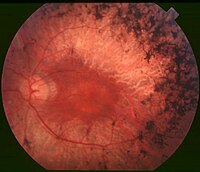
Photo from wikipedia
Retinitis pigmentosa (RP) is a leading cause of inherited blindness characterized by progressive loss of retinal photoreceptor cells. The present study aimed to identify the causative gene mutations in two… Click to show full abstract
Retinitis pigmentosa (RP) is a leading cause of inherited blindness characterized by progressive loss of retinal photoreceptor cells. The present study aimed to identify the causative gene mutations in two Chinese families with autosomal recessive retinitis pigmentosa (arRP). Two Chinese consanguineous arRP families (RP‑2284 and RP‑2360) were recruited in this study, involving totally three affected and 25 unaffected members. All the affected members underwent a complete ophthalmic examination, including fundus photography, multifocal electroretinography (ERG) and full field ERG. Exome sequencing was performed on the three RP patients in the two families, followed by direct Sanger sequencing in all the family members and in 1,260 unrelated controls for validation of the mutations identified. Two homozygous missense mutations in the crumbs homolog 1 (CRB1) gene, which is known to cause severe retinal dystrophies, were found to be related to the phenotype of the two arRP families. The homozygous missense mutation c.1997 T>A in CRB1 was detected in two patients in the RP‑2284 family. The proband in the RP‑2360 family was the only RP patient and was found to carry the novel homozygous missense mutation c.2426 A>C in CRB1. The two mutations were heterozygous or absent in the other healthy family members, and they were absent in the 1,260 controls. The amino acid changes in the CRB1 protein affected by the two mutations were predicted to be damaging by Polyohen‑2. Our study reported two CRB1 mutations causing arRP in two Chinese families, which expands the CRB1 mutation spectrum of RP in the Chinese population and emphasizes the causative role of CRB1 in RP.
Journal Title: Molecular medicine reports
Year Published: 2019
Link to full text (if available)
Share on Social Media: Sign Up to like & get
recommendations!